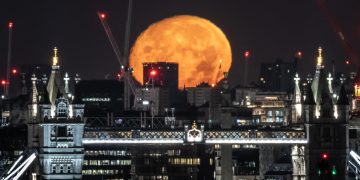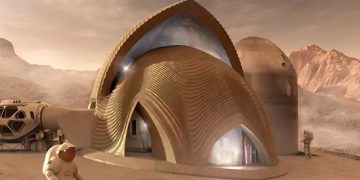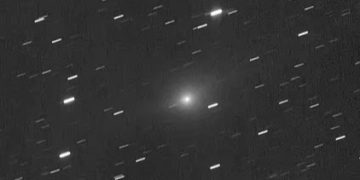NASA astronauts could stay inside a three-storey “inflatable” space home during trips to the Moon.
Space heroes travelling to the lunar surface as part of Nasa‘s Artemis missions could be sleeping inside the giant pod as soon as the 2030s.



Nasa hasn’t confirmed an exact final design for the so-called Lunar Surface Habitat.
But the space agency has released early concepts and schematics for what it might look like.
The idea is that eventually, astronauts will dock at an orbiting space station called the Lunar Gateway – and then descend to the Moon for missions.
“Nasa is currently developing concepts for sustained crewed missions to the lunar surface,” said Nasa’s Paul Kesseler in 2022.
“Sustained missions will occur on annual basis for durations of 30 days or more.
“To house and support the crew, Nasa is exploring the use of a lunar Surface Habitat.”
He added: “The Surface Habitat is the core habitation capability for the Artemis Base Camp.
“As a non-mobile, habitable element, it effectively anchors long-term, human-led exploration at the South Pole of the Moon.”
The three-storey structure would have an inflatable upper section, and would provide its own communications, life support, and waste management – including from the built-in toilets.
And it could serve as a test-bed for future housing on Mars.
The bottom deck of the structure would be an “aluminium pressure vessel”.
And the upper two decks would be contained inside an inflatable that’s just over 21 feet wide.
Nasa notes that the habitat could house “as many as four crew members on shorter surface stays”.
The first level would have airlock access, as well as a work bench, computer station, and access to spacesuit ports.



NASA ARTEMIS MISSIONS – THE TIMELINE

The Artemis mission is designed to reestablish a human presence on the Moon.
The exploration program will involve a series of missions, including the create of a permanent Moon base.
As with all space missions, planned timings can be wildly off – but here’s what we’re expecting…
Artemis I (2022) – Successful uncrewed test of the Space Launch System (SLS) rocket.
Artemis II (2025) – Planned crewed test flight of SLS and the Orion spacecraft.
Artemis III (2026) – Crewed landing on surface of Moon – the first American landing since Apollo 17 in 1972.
Artemis IV (2028) – Second crewed lunar landing mission using Orion, as well as Starship HLS that will dock with Lunar Gateway station near the Moon.
Artemis V (2030) – Third crewed landing, including the delivery of Nasa’s Lunar Terrain Vehicle.
Artemis VI (2031) – Fourth crewed landing, integrating the Crew and Science Airlock with the Lunar Gateway Space Station.
On the second level, there’s an exercise area with a gym machine, a “hygiene” room, and a bio lab.
You’d climb up a central ladder to reach this floor, entering the inflatable portion of the habitat.
An early design for the second floor also flags it as having a “possible window” – which would provide thrilling Moon views, if it’s installed.
Then on the third floor is “space for two private crew quarters”.



They have enough room for “sleeping and stretching”, as well as a personal desk.
This floor would also feature storage, a galley kitchen for meal preparation, and a medical area with a “stowable bed” and potentially privacy curtains too.
Astronauts would be able to use this habitat as a lunar base for missions out into the dark areas of the lunar South Pole.
Nasa’s series of Artemis missions aims to create a permanent lunar outpost.

And the first American crewed landing on the Moon since 1972 is expected to take place in 2026.
But it’s expected that a surface habitat won’t arrive on the Moon until the 2030s.
The Moon – our closest neighbour explained
Here's what you need to know…
- The Moon is a natural satellite – a space-faring body that orbits a planet
- It’s Earth’s only natural satellite, and is the fifth biggest in the Solar System
- The Moon measures 2,158 miles across, roughly 0.27 times the diameter of Earth
- Temperatures on the Moon range from minus 173 degrees Celcius to 260 degrees Celcius
- Experts assumed the Moon was another planet, until Nicolaus Copernicus outlined his theory about our Solar System in 1543
- It was eventually assigned to a “class” after Galileo discovered four moons orbiting Jupiter in 1610
- The Moon is believed to have formed around 4.51billion years ago
- The strength of its gravitational field is about a sixth of Earth’s gravity
- Earth and the Moon have “synchronous rotation”, which means we always see the same side of the Moon – hence the phrase “dark side of the Moon”
- The Moon’s surface is actually dark, but appears bright in the sky due to its reflective ground
- During a solar eclipse, the Moon covers the Sun almost completely. Both objects appear a similar size in the sky because the Sun is both 400 times larger and farther
- The first spacecraft to reach the Moon was in 1959, as part of the Soviet Union’s Lunar program
- The first manned orbital mission was Nasa’s Apollo 8 in 1968
- And the first manned lunar landing was in 1969, as part of the Apollo 11 mission





























